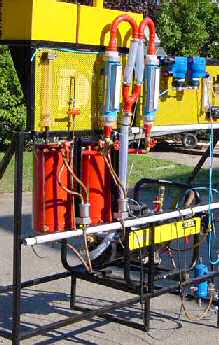Keywords: Geet, Pantone, reactor, reforming, cracking, efficiency, pollution, depollution, hydrocarbons, water, consumption, engine, boiler.
Engineer report on P.Pantone's GEET process by Christophe Martz, ENSAIS engineer. (carried out between June and August 2001 at ENSAIS with the support of ANVAR for obtaining the ENSAIS mechanical engineer diploma)
Introduction: Why? by Christophe Martz, the 26 March 2004.
Here is my entire end of study project on the Pantone process. I made the choice to distribute it fully and freely because this system deserves more attention than the one currently being given to it.
Indeed, it emerged from the study (which turned out to be only a pre-study requiring additional studies) that if the "Geet" phenomenon is not obvious nonetheless (very few claims from Mr. Pantone have been verified):
- the principle of reforming hydrocarbons by recovering heat losses from the exhaust (Geet or other system such as that of chamber)
- and the superheated water (steam) injection system in heat engines
… Deserve serious additional studies ..
Indeed, their development would allow a strong reduction of polluting emissions (mainly on unburned matter and carbon monoxide) and, to a lesser extent, the consumption of fossil fuels.
At a time when climatic upheavals make the headlines almost daily, nothing seems to be in place to develop such ecological solutions, this publication is therefore a call for help in the development of such solutions.
Note to 10 June 2004:
Considering the success of downloading this report (1500 downloads in 2 months, 20 downloads per day on average), I would like to provide some clarifications:
»This report is not to be taken as absolute reference: it is only a project work of end of engineering studies (carried out over 7 months, including 5 months of realization and 2 months of testing) carried out with very limited resources, in any case it is not a thesis work and even less a search for industrialization. It nevertheless appears that the process (or its derivatives) requires (s) further investigation and R&D. It is regrettable that additional studies were not carried out and that in addition, in more than 2 years, no serious proposal for collaboration was made to me when the ANVAR and ADEME were contacted. The engineers of the major manufacturers are obviously also well aware of the system because they carry out a powerful technological watch ”.
Please note that this report is not a "HOWTO" (explanations) for modifying your engine either: it is a scientific process aimed at understanding and experimenting with the system.
On these pages you will find tips for changes: click here.
Summary of the End of Studies Project (written in October 2001)
P.Pantone's GEET (Global Environment Energy Technology) process is a reforming process of hydrocarbon vapors and water before injection into the combustion chamber. This process recovers in a heat exchanger-reactor, the heat of the exhaust gases, entirely lost in a conventional engine, in order to treat the intake gases circulating in an annular space by a chemical-electromagnetic reaction.
The main advantage of this process is a strong depollution, in fact the reaction breaks the molecules of hydrocarbons into smaller molecules to obtain a more volatile gas, the combustion of which is easier and therefore cleaner. The aim of this project is to carry out a first characterization of the process by designing a test bench which will allow the performance of the system to be quantified. The theoretical part defines the bases for explaining the conversion phenomenon occurring in the reactor with the help of experimental findings or by an entirely theoretical method.
According to the promising results observed in depollution and its relatively easy adaptation to any system burning hydrocarbons, we hope that a complementary study will continue the understanding of the process to improve it with a view to industrialization. This would greatly participate in the depollution of fossil fuels, in this sense it would remove their main drawback: polluting combustion.

Content of the study
I) Introduction.
II) The current state of energy use.
III) One solution: the P. Pantone GEET process.
IV) Experiments on the Pantone process
V) Perspectives: Improvements to the mounting of the original patent: directions for alternative engines and adaptation to a boiler.
VI) Conclusion
Download the study
Access to the study is reserved for those registered (free of charge) at the site's newsletter :
The username and password are provided to you in the confirmation email to the Newsletter (Registration for the Newsletter is done in the right column)
Preliminary remark: We advise anyone who is not familiar with the Pantone process to read the study summary first:
Download of the study summary (8 pages in .pdf format, 770 KB)
Download of the full study (117 pages in .pdf format, 3.3 Mo)
Learn more ..
This system leaves you perplexed or you have new hypotheses to propose? Come tell us about it on the forums.
For more information, see the additional pages:

